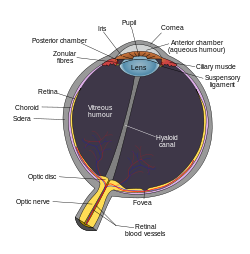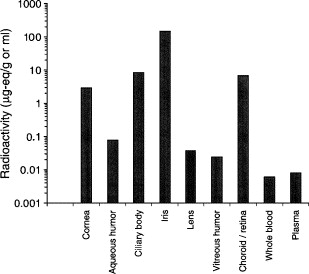朱令案眼科問題的焦點是外眼下毒是否能夠直接擴散到達視網膜。其等價問題就是滴眼液進入內眼之後如何分布。讓我們首先來了解一下必要的解剖和生理知識。Nile引用的知識來自PharmaTutor網站,文章標題是《 REVIEW ON OCULAR DRUG DELIVERY 》。這是網上可以找到的最詳盡的專業資訊。有關滴眼液在內眼的分布和走向全文如下:
After eye drop administration the peak concentration in the anterior chamber is reached after 20–30 min, but this concentration is typically two orders of magnitude lower than the instilled concentration even for lipophilic compounds [21]. From the aqueous humor the drug has an easy access to the iris and ciliary body, where the drug may bind to melanin. Melanin bound drug may form a reservoir that is released gradually to the surrounding cells, thereby prolonging the drug activity. Distribution to the lens is much slower than the distribution to the uvea [22]. Unlike porous uvea, the lens is tightly packed protein rich structure where drug partitioning takes place slowly. Drug is eliminated from the aqueous humor by two main mechanisms: by aqueous turnover through the chamber angle and Sclemm’s canal and by the venous blood flow of the anterior uvea [22] (Fig. 3). The first mechanism has a rate of about 3μl/min and this convective flow is independent of the drug. Elimination by the uveal blood flow, on the other hand, depends on the drug’s ability to penetrate across the endothelial walls of the vessels. For this reason, clearance from the anterior chamber is faster for lipophilic than for hydrophilic drugs. Clearance of lipophilic drugs can be in the range of 20–30 μl/min. In those cases, most of drug elimination takes place via uveal blood flow. Halflifes of drugs in the anterior chamber are typically short, about an hour. The volumes of distribution are difficult to determine due to the slow equilibration of drug in the ocular tissues. The estimates in rabbits range from the volume of aqueous humor (250 μl) up to 2 ml [23]. In the latter case, the slow drug distribution to the vitreous is included in the volume of distribution. This distribution is slow, because the lens prohibits drug access to the vitreous. Flow of aqueous humor from the posterior chamber to the anterior chamber is another limiting factor.
http://www.pharmatutor.org/articles/review-on-ocular-drug-delivery?page=0,2

這段文章的關鍵知識點在這裡:
• peak concentration in the anterior chamber is reached after 20–30 min
• drug has an easy access to the iris and ciliary body
• Distribution to the lens is much slower than the distribution to the uvea, the lens is tightly packed protein rich structure where drug partitioning takes place slowly.
• most of drug elimination takes place via uveal blood flow
• vitreous distribution is slow, because the lens prohibits drug access to the vitreous
滴眼液進入前房後隨房水從後房向前房的循環回流進入脈絡膜靜脈。這是經得起反覆檢驗也很容易理解的科學事實。藥物在內眼的分布晶狀體是一個重要的限制因素,也可以看作是藥物在內眼的分水嶺。在晶狀體前面的,虹膜(iris)和睫狀體(ciliary body)藥物有比較高的分布。到了晶狀體,情況就變了:the lens is tightly packed protein rich structure where drug partitioning takes place slowly. vitreous distribution is slow, because the lens prohibits drug access to the vitreous。很清楚,也很容易理解,藥物不僅很難進入晶狀體而且還會被晶狀體阻擋難以進入其身後的玻璃體。
現在特別注意這句:Distribution to the lens is much slower than the distribution to the uvea。什麼是uvea。Uvea=The vascular middle layer of the eye constituting the iris, ciliary body, and choroid. iris, ciliary body前面都提到了,那麼這裡的choroid又是什麼。Choroid=The dark-brown vascular coat of the eye between the sclera and the retina. Also called choroid coat, choroid membrane.
具備了這些知識,我們來一起解讀一張圖。這張圖來自萬維論壇著名騙子pzzdm的托兒travel1提供的一篇用放射性物質研究藥物在內眼分布的論文。自從nile把他們的騙局當場揭穿,這位騙子就不遺餘力查文獻用來反駁nile所說的滴眼液不能直接擴散到達視網膜。現在我們就來認真研究一下他提供的這份數據。
Fig. 4. Radioactivity in ocular and systemic tissues of cynomolgus monkeys after 5 days of topical 0.2% [14C]brimonidine tartrate b.i.d. Concentrations of radioactivity were measured at 2 h after the last dose of drug. Mean values are shown (n = 4 eyes).
這張條圖清楚表明,藥物透過角膜進入內眼後,濃度分布從高到低是iris, ciliary body 和aqueous humor。再往下依次是晶狀體和玻璃體,其中的濃度比iris低上千倍,與全血濃度比高不過十倍。這與我們上面了解到的知識是吻合的。由於房水循環清除藥物和晶狀體對藥物擴散的屏障,從虹膜到玻璃體藥物濃度已經下降了1000倍。現在問題來了。在choroid/retina 中的濃度與ciliary基本一樣,高於玻璃體數百倍。這是為什麼?
其實原因我們已經知道了。“Distribution to the lens is much slower than the distribution to the uvea.”。choroid(葡萄膜)是uvea(脈絡膜)的一個重要組成部分,相當於相機中的暗箱用來屏蔽光線。前面已經提到,uvea包括iris, ciliary body, and choroid。藥物在uvea上分布比晶狀體多得多。這就是為什麼choroid/retina 的藥物濃度與ciliary基本一樣的原因。choroid/retina中的藥物濃度是choroid中藥物濃度貢獻的,與retina基本沒有關係。視網膜前面的玻璃體藥物濃度已經降到了內眼最低,視網膜沒有從內眼來源的藥物可以使其藥物濃度突然上升數百倍。如果能把retina單獨分離下來測定,其中的藥物濃度應該低於晶狀體和玻璃體,與全血濃度持平。也就是說非常接近平均全血濃度。
騙子travel1對眼球的解剖生理一無所知。不了解系統知識當然會對他煞費苦心查到的論文只知其一不知其二。所以誤打誤撞,以為他查到的論文給nile的打擊是“毀滅性”的。不料想事與願違,這篇論文為早已成熟的眼球解剖生理和藥物動力學知識提供了一個有力的佐證。騙子們不斷賣弄你們的無知和愚蠢即在情理之中,也不出意料之外。但是科學以實證為根據發現的客觀規律不會因為你們的需要作出改變。你們急於洗清騙子臭名的心情nile可以理解。唯一的方法就是公開謝罪,不是向nile而是向所有的網友!







